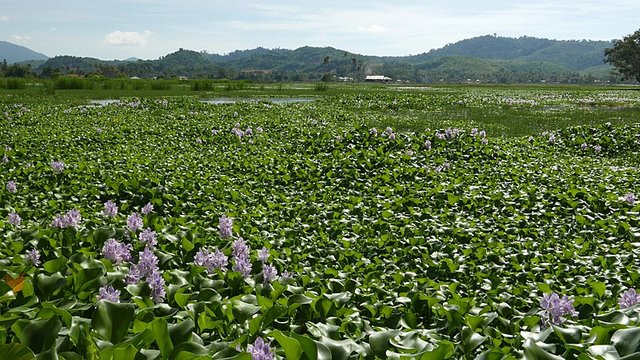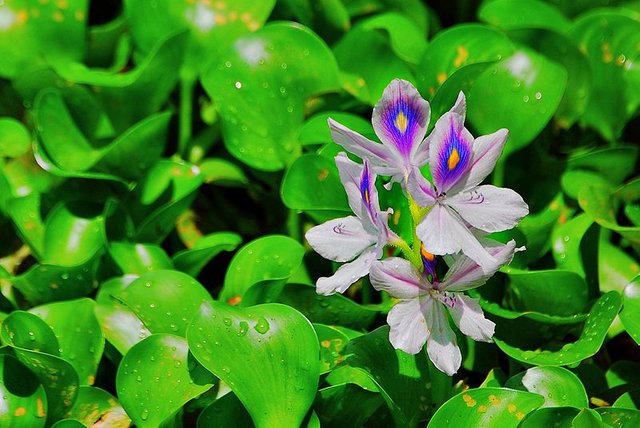EXPLORING THE POTENTIALS OF WATER HYACINTH: THE WORLD'S WORST INVASIVE AQUATIC WEED
Good day to the members of this great community. Thank you for reading and upvoting my last post.
Growing up in a coastal area afforded me the opportunity to see firsthand the destructive effects of water hyacinth (Eichhornia Crassipes) on our waterways. Whenever the weed invades our water bodies it hinders our fun as little children because we can no longer play in the river as usual for fear of being attack by poisonous snakes and other animal like crocodiles that hide under the large mat of the weed to carry out their predatory work. We heard stories of how some otherwise daring swimmers lost their lives under the noxious weed. There was also this superstitious belief among our people that the arrival of the weed signals the readiness of the “strange being” living underneath the river to arrest some offensive soul. As you can imagine already, all the stories we’ve heard help in keeping us kids away from the river side until the weed drift away significantly.
Fishing activities and navigation is seriously hindered at the arrival of the weed to our water bodies as it covers the entire water bodies bringing about a decline in socioeconomic activities in our community and those in its neighborhood. In some other places, it blocks irrigation channels and poses serious challenges to power generation.
The weed also provides a breeding ground for disease-carrying mosquitoes such as the malaria causing anopheles mosquitoes, pests and vectors of diseases harmful to human health. It has also been implicated in harboring the causative agent of cholera.

Water hyacinth is a notorious beautiful water weed that is regarded as the world’s worst invasive aquatic weed.
Recently @steepup wrote extensively on how invasive species threatens the biodiversity of an ecosystem. You can read more about that post here
.jpg)
Water hyacinth is an invasive aquatic weed with an uncanny ability to proliferate and outsmart any growing native plant in its vicinity especially in water with temperature of between 28 and 30 ℃ and pH of 4-8. The weed however ceases to grow when water temperature is above 30℃ or below 10℃. The weed dies once its tip rhizome is frozen. When the weed dies, it pollutes the quality of drinking water and depletes the amount of dissolve oxygen in the water and therefore poses great threat to fishes that may be sensitive to such changes.
There have been various attempts to control the spread of the weed but they are generally very costly and lead only to a temporary removal of the weed. However, researchers are making concerted effort to explore the potential usage of the weed instead of spending huge financial resource at eradicating it to no avail.
The potential of the weed as a biosorbent.
A biosorbent is a biomolecule or biomass with the ability to bind and concentrate selected ion or molecule from aqueous solutions. The sorbent (the biosorbent which is usually in the solid phase) has high affinity for the sorbate (the material to be sorbed, for example metal ion in a solvent) and therefore attract and bound the sorbate by different type of mechanisms.
The term biosorption although similar to bioaccumulation is not the same. Bioaccumulation is a complex metabolically active phenomenon that is energy driven whereas biosorption is metabolically passive and require no energy and can therefore occur in dead cells.
The use of water hyacinth as biosorbent for the treatment of both domestic and industrial effluents containing heavy and toxic metals such as cadmium, arsenic, lead and mercury has been reported by a number of researchers. It has also been shown that this weed has remarkable capacity to mop other chemical substances such as chlorine, nitrates, sulphates, ammonia etc. present in domestic and industrial waste water. In fact, in subtropical areas like Florida, the weed has been applied commercially to control nutrients within wastewaters. Similarly, the potential of water hyacinth was successfully explored by the National Space Technology Laboratories (NSTL) of the United States in treating a polluted lagoon in a bid to lower the cost of treatment of the lagoon and meet the Environmental Protection Agency (EPA) regulation.
The use of water hyacinth as biosorbent has many advantages over other conventional methods such as flotation and membrane processes, chemical precipitation, reverse osmosis, biological processes, ion exchange and electrochemical methods use for the removal of toxic metal from waste water.
Unlike these conventional methods which are associated with limitations such as high energy or reagent requirements and generation of other toxic waste products which also require disposal, water hyacinth as a biosorbent requires no additional nutrient, is relatively cheaper and has high efficiency, generates only minimal chemical and biological sludge plus the possible recovery of metal after adsorption.
The ability of water hyacinth to sequester toxic metal from waste water makes it a good candidate for the purification of polluted water. However, it use must be monitored to prevent it from spreading beyond the area of application.
The potential of the weed as raw material for bio-gas production and animal feedstuff
The negative effects of water hyacinth on aquatic habitat can actually be turned into economic resources for the benefit of people. The weed can be used as raw material in bio gas technology for the production of methane gas which can be used as cooking gas in home and in the generation of electricity. This will reduce the heavy dependence on firewood as fuel and bring about a decline in deforestation occasioned by the felling of tree for firewood.
A number of researchers have demonstrated the potentiality of water hyacinth as animal feedstuff. The weed compare favorably with convectional feedstuff like guinea grass use as silage to feed livestock. The nutritive value of the weed can also be enhanced by combining it with concentrate of other feeds.
The potential of the weed as bio-fertilizer
Water hyacinth can serve as a good source of bio-fertilizer. It can be used directly as green mature especially in growing economic crops like vegetables. The weed has high moisture content which increases the capacity of the soil to hold moisture while at the same time facilitating its adhesion to seed. Farmers around coastal areas where water hyacinth abound can also apply the vegetative waste from biogas production directly on their farms as bio-fertilizer to grow cassava, maize and the likes as it is already being done in some quarters. However, to prevent possible pollution from heavy metal uptake, the weed should be subjected to mineral analysis prior to usage as bio-fertilizer.
The potential of the weed as raw material in local industries.
The weed can serve as raw material for making thatch, mats, basket, pulp and paper, fibre for making chair. People living in areas where these weed abound can actually take advantage of these possibilities to create jobs and alleviate poverty by converting the weed into industrial products. It has however been noted that the use of water hyacinth in the manufacture of poor quality paper is limited due to the low yield of its pulp.
In Conclusion
Water hyacinth constitutes a serious threat to aquatic habitat across the globe especially in poor tropical nations. The cost of eradicating the weed is enormous and the result of such effort has been temporary and unimpressive. The menace post by the weed however can be turned into blessing especially in growing economies like Nigeria, if the various potentials of the weed as enumerated in this post are explored and developed for the benefit of the populace.
Thank you for stopping by to read my post. Until the next time, keep on steeming.
Well done @saintgentle ,water hyacinth presence on water body is not only dangerous to water ecosystem, but to man too as you have rightly stated. About 16 years ago, in Lagos Nigeria, it presence on water surface deceived some people thinking it was a field, the rest was history. However, it's positive impact you stated here really open my eyes to it's importance to environmentalist. Nice write up.👍
Thank you at @steepup for finding the time to read and upvote the write up. Your comment is very encouraging and highly appreciated.
You are welcome. The post is quite informative.
Congratulations @saintgentle! You received a personal award!
You can view your badges on your Steem Board and compare to others on the Steem Ranking
Do not miss the last post from @steemitboard: